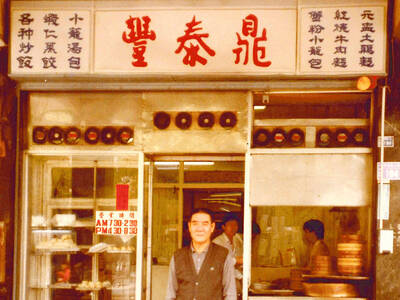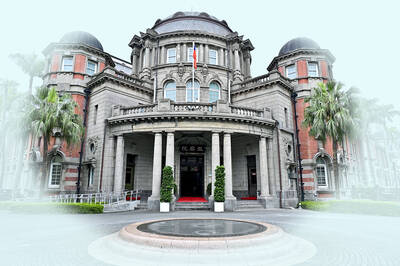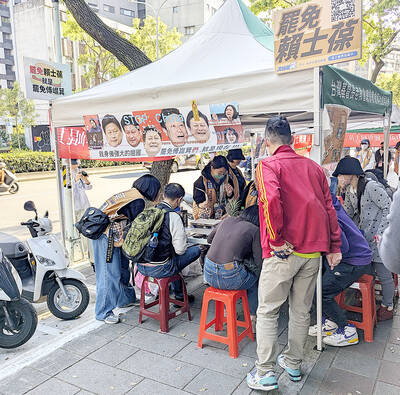For more than 20 years, fashion designer Isabelle Wen (溫慶珠) has shown that she is not afraid to derive inspiration from sources as diverse as Sufism, Mercury (the planet and the element) and Nancy Sinatra songs.
“I think designing things is like writing a diary and I draw on my own life for inspiration. Every season has a different mood. It is like presenting a story through clothing,” says Wen.
Her label’s upcoming spring/summer 2009 collection is partly inspired by the revolutionary and idealistic spirit of the 1960s. Highlights include a dress made of tiers of soft silk chiffon dyed in graduating tones of misty gray, a printed blouse whose circular pattern is echoed in discreet but richly textured round appliques, and classic boot-cut jeans offset by pockets encrusted with crystals and stones — a Wen signature, along with other unabashedly feminine flourishes like ruffles, pleated tulle and shimmery, embroidered fabrics.
Wen’s background is as kaleidoscopic as her colorful dresses. Her father was a general in the Chinese Nationalist Party (KMT) before moving with Wen’s mother to Taiwan in 1949. He served as a police chief in Tainan, but Wen describes both her parents as artists at heart who encouraged the same in their children. Wen’s first forays into fashion design happened when her mother took her to tailors to have her sketches turned into clothing for Wen’s own wardrobe.
But the launch of her own label in 1976 came only after Wen had taken a few detours. She studied tourism at Tamsui’s Oxford College (now part of Aletheia University, 真理大學) before training to be a painter under the tutelage of renowned artist O How-nien (歐豪年) for six years. Wen still sees few boundaries between the world of fine art and fashion. Her fall/winter 2008 collection was named after Amedeo Modigliani and used many of the deep blue and gray tones that feature in the Italian painter’s work.
Wen has also diligently pursued the diversification of her brand; her other ventures include a building on Renai Road (仁愛路) that contains a cafe, restaurants and a bar and the trendy East District eateries Sofa (which closed shortly after this interview), Midnight Cafe and Butterfly.
In an interview at her studio in Shilin, Wen talked about the impact of the economy on her businesses, and why, even though she’s held presentations in Paris and opened stores in the US (which she has since closed), she’d rather stay within Asia than look towards Europe and the US as she expands her brand.
Taipei Times: You seem to have pursued branding beyond your fashion label pretty aggressively compared to other designers, especially with the opening of restaurants. How did you decide to do that?
Isabelle Wen: To be honest, I fell into that by accident. It wasn’t that I wanted to take a particular road for my business or that I wanted to be unique. FiFi and Khaki came about because the building they are in came on the market about 10 years ago. It was a happy accident. Because the building is on Renai Road, I thought it presented a great opportunity. In fact, I actually told some of my friends about it first and encouraged them to buy it for their own ventures.
When I finally purchased it myself, I decided that I absolutely did not want the entire building to be dedicated only to fashion. I wanted it to be like a small landmark, a destination. You know, Renai Road is so boring. It’s beautiful, but there was nothing. A hotel and a bunch of banks and that was about it. So what I opened had to be very interesting and since I am a fashion designer I wanted to apply some of my own aesthetic sensibility to what we created.
When I talked to my sister Lily (溫慶玉) about this, the first thing we decided was that we must absolutely serve Chinese food. I adore Chinese food and I don’t think there is a single cuisine in the world that is more delicious. Sanyu (常玉廳) is named after my favorite artist, who I absolutely adore. He moved from China to France, where he studied art, and as a result his work had a very particular style, with a Western sense of color. That influenced the restaurant’s ambiance and the colors we used in there. The food we serve there is based on recipes I remember from my childhood. The menu is very nostalgic for me and at the same time typical of old Chinese-style cuisine.
When you go to the building itself, you can go shopping in FiFi’s Market, go to Khaki for coffee, then head up to Sanyu before finishing the evening at W Bar on the third floor, which has a more dramatic atmosphere. I wanted to create something that would let people know that Taiwan is not just about oyster omelets or Snake Alley.
TT: What do you think the place of Taiwanese designers in the international fashion scene is?
IW: I think Taiwanese designers, in terms of their fashions, have already reached the same standards as international designers. But Taiwanese culture doesn’t really focus on fashion, because every country has to get to a point where it is very wealthy in order to do so and Taiwan has only really reached that level within the last 30 years or so. So from that aspect, Taiwan fashion is still developing.
In my own background, I didn’t have any big investors or big companies backing me up, so I built my business piece from piece, starting from my studio on Dihua Street (迪化街). I think that Taiwanese designers are on the same footing with the rest of the world in terms of high fashion, but what we don’t have is the same kind of financial backup. Our disadvantage is that we don’t have such a big stage and investor support. We don’t have the ability that major international brands do of being able to drop several million dollars on a single ad campaign.
TT: Shiatzy Chen (王陳彩霞) recently showed in Paris Fashion Week. Since you’ve already held presentations on your own in Paris, do you think you might also want to participate in the official fashion week there?
IW: To be honest, sometimes I don’t think I have the spirit of a businessperson [laughs]. People call me every day asking when am I going to go to China or Europe or America, but I like focusing on what I am doing here.
TT: Will you be expanding your business here with new restaurants or other projects?
IW: Doing business is pretty nerve-wracking right now. Instead of opening a new restaurant, I think I might have to close one or two. I think we have too many. It has to do with the economy, which has impacted our non-fashion businesses. We have to come out with a new collection every season, regardless of what the economic climate is, but I think we have to be a bit more careful about our other projects. In the past, it was like whenever we wanted to open a new restaurant, we would open it. But now we have to be more methodical and we would have to spend a lot of time putting together a business model that is truly unique, otherwise it’s just not worth it.
TT: Which restaurants might you close?
IW: I haven’t really put a lot of thought into it, because it’s a difficult thing to think about. But we have a cafe, a very cute cafe named Midnight Cafe, and even though I really love it, we might have to let go of it because the rent is climbing.
TT: How has the economy impacted the fashion side of your business?
IW: Our customers are all a bit more mature, in that they are not teenagers, they are women who are around 30 and above. I think our typical client is someone who is well off. At the same time, I don’t think a single person has not been shaken by the crisis. So a customer who previously purchased NT$30,000 to NT$40,000 in clothes every season might just buy half of that now. Their spending habits have definitely changed.
TT: Do you think it has impacted the way you approach clothing design? Have you started thinking about catering to women who right now want to spend their money on investment pieces they can keep and wear for years instead of trendier styles?
IW: As a matter of fact, when I was headed out this morning, my mom called me and that’s the first thing she said after asking about my health: “Fifi [Wen’s nickname], let me tell you, if you want to design clothes, you have to design classics, the basics, because the economic crisis has changed everyone. They don’t want to buy luxury clothes like yours.” She said this to me, it was very funny and it’s a coincidence you bring it up.
But I think every designer has a trademark style and I don’t think any one of us would alter what we do because of the economy. I don’t have it in me to design Gap or Banana Republic-like clothing. That’s not my character. Even in this economic climate, you’ll still find clothes that are fun. It’s the most beautiful, extreme and luxurious designs in each collection that capture the attention of consumers. But not all pieces are like that; I would say only about a third of each season is like that.
For my spring/summer collection, instead of toning down my designs, I focused on making them more comfortable and free. I think freedom is this season’s most important theme. Freedom and romance, instead of drama. I don’t think it’s what like most people assume, that an investment piece has to be very basic. I think it’s the opposite actually: a piece of clothing must be very beautiful and unique and very luxurious so you will want to keep it.
TT: Your last collection was named after Modigliani. How did you take your inspiration from his paintings and translate it into clothing?
IW: Actually, I did the designs first for last season and then I chose the name. I always think about the relationship between fine art and clothing because I’ve always been a painter, starting from when I was a child. I’ve never separated the two things. Last season was about the colors. I used a lot of blues and dark grays and those colors are very reminiscent of Modigliani. It’s very deep and mysterious.
A lot of the clothes also have small collars crocheted from yarn, which give them a 1920s feel. One of Modigliani’s strong points was his portraits and he was very good at capturing the detail in clothing. I saw those paintings and incorporated elements from them into my clothes.
TT: What is the inspiration for this season’s collection?
IW: Our spring/summer collection is called “June.” Spring and summer both evoke a sentimental mood for me, one that’s not so cheerful and carefree. And in the next few years, even with the recession, the world needs to slow down and it needs love and peace. It’s a lot like the 1960s, actually. Back then there were a lot of artsy people who wanted to challenge traditions and customs and that is how the hippies were born. This collection kind of has that atmosphere and the ideas in it. We joke that it’s for royal hippies, hippies with a certain amount of purchasing power.
When I think of the women who wear my clothing, I think it appeals to them not just because it’s pretty, but also because they have minds of their own and don’t want to look like everyone else. I make things for women who like art and who aren’t really into super trendy clothes but designs that take their cues from art and culture instead. They also like romantic clothing, and they are financially independent and earn their own money.
I also have clients who will save up and purchase my clothing every two or three months. I really appreciate those customers and I don’t feel like you have to be rich to enjoy my clothing. My intention isn’t to design a hyper-exclusive brand. I hope that everyone can afford to wear my clothes.
TT: I read in a previous interview that when you started out about 20 years ago, Taiwanese consumers favored international designers over Taiwanese brands. Do you think that is still the case?
IW: I think Taiwanese people now love Taiwanese brands. That’s how I feel, or maybe that’s because I’ve been lucky. But international brands have a lot of power and financial clout.
TT: What countries do you think are the most receptive to Taiwanese designers?
IW: About 15 years ago, I opened a few stores in the United States and the reception was actually very warm. Customers thought it was unusual and they liked that, but we didn’t have the manufacturing resources to expand our size range to fit the different requirements there, so I ended up closing the stores.
TT: Do you want to open stores in Europe?
IW: I think the moment has passed in Europe and America. They are no longer fresh markets, because the fashion industry there is already so saturated. I think in the next 10 years we will have to look toward the Chinese market if Taiwanese brands want to expand.

March 24 to March 30 When Yang Bing-yi (楊秉彝) needed a name for his new cooking oil shop in 1958, he first thought of honoring his previous employer, Heng Tai Fung (恆泰豐). The owner, Wang Yi-fu (王伊夫), had taken care of him over the previous 10 years, shortly after the native of Shanxi Province arrived in Taiwan in 1948 as a penniless 21 year old. His oil supplier was called Din Mei (鼎美), so he simply combined the names. Over the next decade, Yang and his wife Lai Pen-mei (賴盆妹) built up a booming business delivering oil to shops and

The Taipei Times last week reported that the Control Yuan said it had been “left with no choice” but to ask the Constitutional Court to rule on the constitutionality of the central government budget, which left it without a budget. Lost in the outrage over the cuts to defense and to the Constitutional Court were the cuts to the Control Yuan, whose operating budget was slashed by 96 percent. It is unable even to pay its utility bills, and in the press conference it convened on the issue, said that its department directors were paying out of pocket for gasoline

On March 13 President William Lai (賴清德) gave a national security speech noting the 20th year since the passing of China’s Anti-Secession Law (反分裂國家法) in March 2005 that laid the legal groundwork for an invasion of Taiwan. That law, and other subsequent ones, are merely political theater created by the Chinese Communist Party (CCP) to have something to point to so they can claim “we have to do it, it is the law.” The president’s speech was somber and said: “By its actions, China already satisfies the definition of a ‘foreign hostile force’ as provided in the Anti-Infiltration Act, which unlike

Mirror mirror on the wall, what’s the fairest Disney live-action remake of them all? Wait, mirror. Hold on a second. Maybe choosing from the likes of Alice in Wonderland (2010), Mulan (2020) and The Lion King (2019) isn’t such a good idea. Mirror, on second thought, what’s on Netflix? Even the most devoted fans would have to acknowledge that these have not been the most illustrious illustrations of Disney magic. At their best (Pete’s Dragon? Cinderella?) they breathe life into old classics that could use a little updating. At their worst, well, blue Will Smith. Given the rapacious rate of remakes in modern